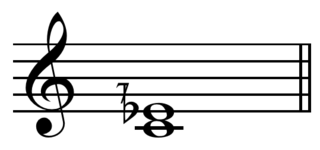Related Research Articles

The harmonic series is the sequence of harmonics, musical tones, or pure tones whose frequency is an integer multiple of a fundamental frequency.

In music, just intonation or pure intonation is the tuning of musical intervals as whole number ratios of frequencies. An interval tuned in this way is said to be pure, and is called a just interval. Just intervals consist of tones from a single harmonic series of an implied fundamental. For example, in the diagram, if the notes G3 and C4 are tuned as members of the harmonic series of the lowest C, their frequencies will be 3 and 4 times the fundamental frequency. The interval ratio between C4 and G3 is therefore 4:3, a just fourth.
In musical notation, an accidental is a symbol that indicates an alteration of a given pitch. The most common accidentals are the flat and the sharp, which represent alterations of a semitone, and the natural, which cancels a sharp or flat. Accidentals alter the pitch of individual scale tones in a given key signature; the sharps or flats in the key signature itself are not considered accidentals.
Microtonality is the use in music of microtones — intervals smaller than a semitone, also called "microintervals". It may also be extended to include any music using intervals not found in the customary Western tuning of twelve equal intervals per octave. In other words, a microtone may be thought of as a note that falls "between the keys" of a piano tuned in equal temperament.

Harry Partch was an American composer, music theorist, and creator of unique musical instruments. He composed using scales of unequal intervals in just intonation, and was one of the first 20th-century composers in the West to work systematically with microtonal scales, alongside Lou Harrison. He built his own instruments in these tunings on which to play his compositions, and described the method behind his theory and practice in his book Genesis of a Music (1947).
Benjamin Burwell Johnston Jr. was an American contemporary music composer, known for his use of just intonation. He was called "one of the foremost composers of microtonal music" by Philip Bush and "one of the best non-famous composers this country has to offer" by John Rockwell.

James Tenney was an American composer and music theorist. He made significant early musical contributions to plunderphonics, sound synthesis, algorithmic composition, process music, spectral music, microtonal music, and tuning systems including extended just intonation. His theoretical writings variously concern musical form, texture, timbre, consonance and dissonance, and harmonic perception.

In music theory, a minor third is a musical interval that encompasses three half steps, or semitones. Staff notation represents the minor third as encompassing three staff positions. The minor third is one of two commonly occurring thirds. It is called minor because it is the smaller of the two: the major third spans an additional semitone. For example, the interval from A to C is a minor third, as the note C lies three semitones above A. Coincidentally, there are three staff positions from A to C. Diminished and augmented thirds span the same number of staff positions, but consist of a different number of semitones. The minor third is a skip melodically.

In music theory, a minor chord is a chord that has a root, a minor third, and a perfect fifth. When a chord comprises only these three notes, it is called a minor triad. For example, the minor triad built on A, called an A minor triad, has pitches A–C–E:
A schismatic temperament is a musical tuning system that results from tempering the schisma of 32805:32768 to a unison. It is also called the schismic temperament, Helmholtz temperament, or quasi-Pythagorean temperament.

In music theory, pitch spaces model relationships between pitches. These models typically use distance to model the degree of relatedness, with closely related pitches placed near one another, and less closely related pitches farther apart. Depending on the complexity of the relationships under consideration, the models may be multidimensional. Models of pitch space are often graphs, groups, lattices, or geometrical figures such as helixes. Pitch spaces distinguish octave-related pitches. When octave-related pitches are not distinguished, we have instead pitch class spaces, which represent relationships between pitch classes. Chordal spaces model relationships between chords.

In music theory, a comma is a very small interval, the difference resulting from tuning one note two different ways. Traditionally, there are two most common comma; the syntonic comma, "the difference between a just major 3rd and four just perfect 5ths less two octaves", and the Pythagorean comma, "the difference between twelve 5ths and seven octaves". The word comma used without qualification refers to the syntonic comma, which can be defined, for instance, as the difference between an F♯ tuned using the D-based Pythagorean tuning system, and another F♯ tuned using the D-based quarter-comma meantone tuning system. Intervals separated by the ratio 81:80 are considered the same note because the 12-note Western chromatic scale does not distinguish Pythagorean intervals from 5-limit intervals in its notation. Other intervals are considered commas because of the enharmonic equivalences of a tuning system. For example, in 53TET, B♭ and A♯ are both approximated by the same interval although they are a septimal kleisma apart.
In music, 72 equal temperament, called twelfth-tone, 72-TET, 72-EDO, or 72-ET, is the tempered scale derived by dividing the octave into twelfth-tones, or in other words 72 equal steps. Each step represents a frequency ratio of 72√2, or 16+2⁄3 cents, which divides the 100 cent "halftone" into 6 equal parts and is thus a "twelfth-tone". Since 72 is divisible by 1, 2, 3, 4, 6, 8, 9, 12, 18, 24, 36, and 72, 72-EDO includes all those equal temperaments. Since it contains so many temperaments, 72-EDO contains at the same time tempered semitones, third-tones, quartertones and sixth-tones, which makes it a very versatile temperament.

In music, the septimal minor third, also called the subminor third or septimal subminor third, is the musical interval exactly or approximately equal to a 7/6 ratio of frequencies. In terms of cents, it is 267 cents, a quartertone of size 36/35 flatter than a just minor third of 6/5. In 24-tone equal temperament five quarter tones approximate the septimal minor third at 250 cents. A septimal minor third is almost exactly two-ninths of an octave, and thus all divisions of the octave into multiples of nine have an almost perfect match to this interval. The septimal major sixth, 12/7, is the inverse of this interval.

Five-limit tuning, 5-limit tuning, or 5-prime-limit tuning (not to be confused with 5-odd-limit tuning), is any system for tuning a musical instrument that obtains the frequency of each note by multiplying the frequency of a given reference note (the base note) by products of integer powers of 2, 3, or 5 (prime numbers limited to 5 or lower), such as 2−3·31·51 = 15/8.

In musical tuning, a lattice "is a way of modeling the tuning relationships of a just intonation system. It is an array of points in a periodic multidimensional pattern. Each point on the lattice corresponds to a ratio. The lattice can be two-, three-, or n-dimensional, with each dimension corresponding to a different prime-number partial [pitch class]." When listed in a spreadsheet a lattice may be referred to as a tuning table.
Wolfgang von Schweinitz is a German composer of classical music and an academic teacher.
Catherine Lamb is an American composer and violist, and a winner of the 2020 Ernst von Siemens Composer Prize.
References
- ↑ "Marc Sabat biography" . Retrieved 1 February 2022.
- ↑ "Marc Sabat". swr.online. 31 August 2007. Retrieved 1 December 2021.
- ↑ "BERLIN IN LIGHTS – The Music: KNM Berlin, Saturday, 10 Nov at 7 PM". berlinlights.carnegiehall.org. Retrieved 1 December 2021.
- ↑ "Plainsound Music Edition – YouTube" . Retrieved 1 December 2021– via YouTube.
- ↑ "The Extended Helmholtz-Ellis JI Pitch Notation" (PDF). Retrieved 1 December 2021.
- ↑ "An Algorithm for Real-Time Harmonic Microtuning" (PDF). Retrieved 1 December 2021.
- ↑ "Thomas Nicholson". superparticular.com. Retrieved 24 July 2024.
- ↑ "HEJI 2020" (PDF). Retrieved 1 February 2022.
- ↑ "Digits and Sounds: Celebrating Clarence Barlow". youtu.be. Retrieved 24 July 2024.
- ↑ "Marc Sabat : music & writings" . Retrieved 1 February 2022.
- ↑ "Marc Sabat". udk-berlin.de. Retrieved 1 December 2021.
- ↑ "Grant Recipient Details – VATMH (en)". vatmh.org. Retrieved 1 December 2021.
- ↑ "Villa Massimo | Stipendien". villamassimo.de. Archived from the original on 19 June 2013. Retrieved 1 December 2021.
- ↑ "HSO". harmonicspace.org. Retrieved 24 July 2024.